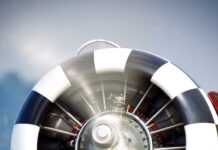In the air show industry, there has been an ongoing debate about the relative pros and cons of wearing a helmet during air show performances. While the ultimate decision is a personal one, here are some factors to consider:
Negatives:
Weight — While a typical lightweight aviation helmet may only weigh 2-3 pounds, under increased G-force during maneuvering the helmet can place significant strain on the neck. This weight can be a big problem in a crash and can actually increase the risk of injury or death. Auto racing has required for years that the helmet be restrained to protect against severe neck injury during impact. These negatives can be partially negated by maintaining a steady workout regimen involving the neck muscles.
Discomfort– Flying with an improperly fitted helmet can hurt and can cause a serious distraction from the task at hand: flying. The helmet will also trap heat against your head, which increases body temperature. This can be a problem in the summer inside an already hot cockpit.
Positives:
Impact protection — The obvious and overriding reason to wear a helmet is to provide impact protection in the event of an accident. One good example would be in the event of a bailout when the risk of striking the aircraft upon exit can be a real hazard. Another significant danger (in aerobatic aircraft especially) is the risk of the canopy failing during flight and impacting the pilot’s head.
Professional look — We are in the business of aerial entertainment, and presenting a professional image is a big part of the equation. Wearing a helmet and flight suit simply looks good, and presents an image of safety.
If you decide that wearing a helmet is for you, make sure to take the time to figure out which model will work best for your application. Getting the helmet fitted properly with good working communications installed is also important. It may take some time getting used to flying with a helmet, but there may come a day when you are glad you wear it!
Finally, as you consider whether or not to use a helmet, consider this: there are precious few air show performers who have been involved in a serious accident who will report that they were glad they didn’t have a helmet. But there are many air show performers who will tell you that they very likely owe their lives to the fact that they were wearing a helmet at the time of an accident. Although Buck Roetman’s accident last weekend in Idaho is still being investigated, Buck believes that his experience would have had a tragic ending had he not been wearing a helmet, as evidenced by serious damage to that helmet and a small bruise on his forehead.








